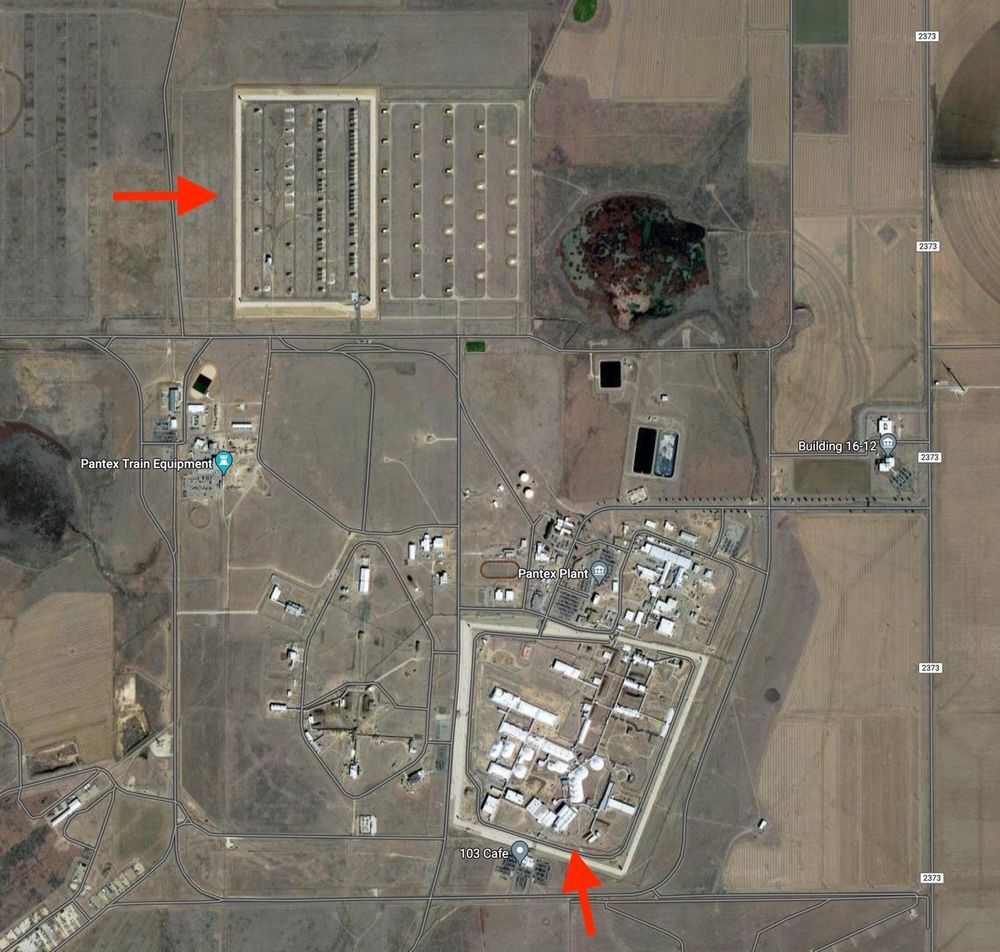Texas wildfires force major nuclear weapons facility to briefly pause operations
By Jessica McKenzie, François Diaz-Maurin | February 28, 2024
 Smoke column from the Windy Deuce in Hutchinson County fire along Lake Meredith. This photo was taken by Mitchell Monk, a Texas A&M crew member on the scene. (Source: inciweb.nwcg.gov)
Smoke column from the Windy Deuce in Hutchinson County fire along Lake Meredith. This photo was taken by Mitchell Monk, a Texas A&M crew member on the scene. (Source: inciweb.nwcg.gov)
A wildland fire in the Texas Panhandle forced the Pantex plant, a nuclear facility northeast of Amarillo, to temporarily cease operations on Tuesday and to evacuate nonessential workers. Plant workers also started construction on a fire barrier to protect the plant’s facilities.
The plant resumed normal operations on Wednesday, officials said.
“Thanks to the responsive actions of all Pantexans and the NNSA Production Office in cooperation with the women and men of the Pantex Fire Department and our mutual aid partners from neighboring communities, the fire did not reach or breach the plant’s boundary,” Pantex said in a social media post on Wednesday afternoon.
At a press conference Tuesday evening, Laef Pendergraft, a nuclear safety engineer with the National Nuclear Security Administration production office at Pantex, said the evacuations were out of an “abundance of caution.”
“Currently we are responding to the plant, but there is no fire on our site or on our boundary,” Pendergraft told reporters.
The 90,000-acre Windy Deuce fire burning four to five miles to the north of the Pantex plant was 25 percent contained as of late Wednesday afternoon.

Until the fire is fully contained, it will continue to pose a threat to the nearby Pantex plant, says Nickolas Roth, the senior director of nuclear materials security at the Nuclear Threat Initiative. “I think the sign that the coast is clear is that the fire is no longer burning,” he told the Bulletin. “One can imagine many reasons operations would resume.”
The Smokehouse Creek fire burning further northeast of Pantex, which was first reported on Monday afternoon, is already the second-largest wildfire in Texas history. More than 850,000 acres have burned, and as of Wednesday afternoon, the fire was just three percent contained. The largest wildland fire in Texas history was the East Amarillo Complex Fire in the winter of 2006, which burned over 900,000 acres.
Although climate change has made wildfire threats a year-long risk in Texas, according to the Western Fire Chiefs Association, the most severe wildfire threats are between the months of February through April (the winter wildfire season) and August through October (the summer wildfire season). Winter wildfires like Smokehouse Creek are the result of high winds that dry out potential fuel and, once a fire is ignited, cause them to spread faster and further.
Above-average rainfall in the Texas panhandle last spring means that grasses and shrubs flourished, creating ample fuel for fires this winter.
While the specific cause of the Smokehouse Creek fire has not yet been identified, climate change is making explosive wildfires more likely, with serious implications for the country’s nuclear weapons programs.
Since 1975, the Pantex plant has been the United States’ primary facility responsible for assembling and disassembling nuclear weapons. It is one of six production facilities in the National Nuclear Security Administration’s Nuclear Security Enterprise.
In addition to warhead surveillance and repair, the plant is currently working on the full scale production of the B61-12 guided nuclear gravity bomb and 455-kiloton W88 Alteration (Alt) 370 warhead as part of the broader US nuclear weapons life-extension and modernization programs. The plant handles significant quantities of uranium, plutonium, and tritium, in addition to other non-radioactive toxic and explosive chemicals.
If a wildfire were to impact the site directly, the health and safety implications could be enormous.
“I don’t like to speculate in terms of worst-case scenarios,” Roth told the Bulletin. “The potential for danger if a fire ever broke out at a site with weapons usable nuclear material is quite great.”
“The danger from plutonium really comes from inhaling particulates,” Dylan Spaulding, a senior scientist in the Global Security Program at the Union of Concerned Scientists, explained on a podcast in 2023. “So if powder is inhaled, or if somehow powder were to be dispersed through, say, a big fire or some kind of incident at the site, that would certainly pose a risk for surrounding communities.”
Up to 20,000 plutonium cores, or “pits,” from disassembled nuclear weapons can be stored on site. (The exact figure is classified, but experts contacted by the Bulletin said the current number of “surplus” plutonium pits already dismantled is likely to be around 19,000, plus an additional unknown number of backlog pits awaiting disassembly.)
But as Robert Alvarez wrote in the Bulletin in 2018, the plutonium is stored in facilities built over half a century ago that were never intended to indefinitely store nuclear explosives. After extreme rains flooded parts of the facility in 2010 and 2017, some of the containers began showing signs of corrosion.
A 2021 review by the Defense Nuclear Facilities Safety Board of the Pantex plant’s operations found that an increasing number of plutonium pits are stored in unsealed containers. These pits are either “recently removed from a weapon, planned to be used in an upcoming assembly or life extension program, or pending surveillance,” the board explained. The board previously recommended that these pits be repackaged into sealed insert containers for their safe long-term staging. But the plant personnel “stated it is only achieving approximately 10 percent of its annual pit repackaging goals, citing a lack of funding and priority.”
“To my knowledge, most of the pits stored at Pantex are in an area at the north edge of the site in an area called Zone 4 within bunkers covered with earth,” Spaulding wrote in an email to the Bulletin. “The site is surrounded mostly by agricultural land (crops and grasslands). That means that if wildfire did reach the site, it would probably move quickly and not be very long lived (as opposed to a forest fire, which could burn more intensely for longer periods, such as happened around [the Los Alamos National Laboratory] in 2000 and 2011).”

Separately, the amount of explosive chemicals currently stored at the site is unknown. “But the facility disassembles and reassembles chemical explosives from weapons that are present at any given time,” Hans Kristensen, the director of the Nuclear Information Project at the Federation of American Scientists, wrote in an email to the Bulletin. “High explosives would likely be in the weapons bays or bunkers that are built to withstand fire,” Kristensen added.
Most of the facility’s operations take place on 2,000 acres of the site’s 18,000 acres. The facility has about 650 buildings and has its own fire department staffed by 70 employees.
According to a 2021 Department of Energy report on emergency preparedness at the Pantex plant, produced by Consolidated Nuclear Security, LLC, between October 2015 and September 2020: “The fire department is principally an industrial fire service, capable of responding to urban-type fires within the Pantex boundary. The fire department maintains specific capabilities for dealing with fires involving hazardous substances and materials unique to the Pantex mission. The fire department also maintains an adequate capability to address wildland fires… CNS validated its wildland fire capability in two exercises and its emergency services dispatch center capability in 13 exercises during the period.”
A Department of Energy report published in April 2022 on fire protection at the Pantex, which identified several weaknesses within the plant, did not discuss risks from wildland fires.
“The event is obviously a stark reminder of the dangers of climate change on even high security nuclear weapons facilities,” said Kristensen.
But as other authors have previously argued in the Bulletin, climate change is a blind spot in US nuclear weapons policy. “All of these [nuclear] structures were built on the presumption of a stable planet. And our climate is changing very rapidly and presenting new extremes,” Alice Hill, a senior fellow for energy and the environment at the Council on Foreign Relations, told the Bulletin in 2021.
“The future is going to be one where nuclear facilities are going to increasingly have to respond to crises of one form or another,” said Roth. “And their ability to adapt and their ability to develop resilient systems is going to likely be the difference between a disaster, or not.”
This story was updated on February 29, 2024, to include additional expert comments.
Together, we make the world safer.
The Bulletin elevates expert voices above the noise. But as an independent nonprofit organization, our operations depend on the support of readers like you. Help us continue to deliver quality journalism that holds leaders accountable. Your support of our work at any level is important. In return, we promise our coverage will be understandable, influential, vigilant, solution-oriented, and fair-minded. Together we can make a difference.
Keywords: Pantex, Texas, climate crisis, extreme weather, nuclear weapons, plutonium pits, wildfire
Topics: Climate Change, Nuclear Weapons

















Wow, I only learnt about the Pantex plant in the last few years. I had no idea it was situated on so much land, 18,000 acres! 650 Buildings! Very interesting. It makes perfect sense, of course, being the preeminent bomb assembly and disassembly facility in all of the United States. I have complete faith that the site planners and local authorities can handle the threat presented by the fire. But then, nobody has any cause to condemn my optimistic reasoning.